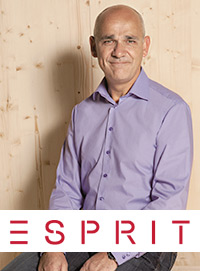"As part of the fashion industry, we are influencers on society and with this come a great responsibility to propel positive and systemic change."
Charles Dickinson, Senior Vice President - Head of Global Quality Management & Sustainability, Esprit.
 Esprit is a publicly-owned manufacturer of fashion apparel and accessories. Its headquarters is in Hong Kong and Germany. The company’s initiatives towards sustainable manufacturing has not only been recognized and applauded, but its efforts in encouraging the same throughout the supply chain has also been appreciated. Be it social, environmental, or economical, its sustainability actions have always been appreciated in the industry.
Esprit is a publicly-owned manufacturer of fashion apparel and accessories. Its headquarters is in Hong Kong and Germany. The company’s initiatives towards sustainable manufacturing has not only been recognized and applauded, but its efforts in encouraging the same throughout the supply chain has also been appreciated. Be it social, environmental, or economical, its sustainability actions have always been appreciated in the industry.
What does sustainable fashion mean to you?
Sustainable fashion is a long-term commitment and not just a trend; it needs to be an injection across the entire value chain of any organization, rooted deeply in the core of each strategic and tactical business decision. Personally, I believe it is mostly about education and investing in people: sharing best practices with our partners in the industry across the entire supply chain, being engaged with peers, continuously learning, investing in research and development of alternative materials and methods, open-mindedness, curiosity and responsible application of all aspects of product creation from fibres through to finished products.
Having a holistic view is fundamental to contributing to a long-term change within sustainability!
What are the steps taken by Esprit to produce sustainable garments?
Esprit has always taken sustainability very seriously, starting from the sixties at the company’s beginning. We care about the environment, resources and employees, whether they are direct Esprit employees or working in distant parts of the supply chain. Being sustainable also means creating high quality fashion that customers can enjoy for a long time, and making sure that we produce this fashion in a responsible way.
It is a continuous journey and we strive every day to make a difference - let me give you some examples how we do this:
A couple of years ago, we kicked off our first Sustainable Design Workshop with more than 50 designers, technicians and product managers from our divisions as well as industry specialists and suppliers of sustainable fabrics and equipment who presented their expert knowledge about sustainable topics in the fashion industry. The concept of these workshops is to bring together sustainable expertise around one table and to be inspirational.
Education that allows for creativity is key! That is why we are also sponsoring - for the third year in a row- the annual sustainable fashion design competition, the EcoChic Design Award, for emerging young talents.
I would also like to mention our engagement with stakeholders and the industry through associations such as: the Sustainable Apparel Coalition where we are a founding circle member, the Zero Discharge of Hazardous Chemicals Group which is committed to help lead the industry towards zero discharge of hazardous chemicals by 2020, and Better Work, a collaboration between the International Labour Organization (ILO) and the International Finance Corporation (IFC) to improve workplace conditions in Vietnam, Indonesia and Cambodia.
What is the role of a clothing brand in promoting sustainable products in ways that are environmentally, socially and economically viable?
As a clothing brand, we are in a trend and zeitgeist driven environment. Fashion is not only fulfilling functional demands - it can also be an expression of mood, orientation or status among many other attributes. As part of the fashion industry, we are influencers on society and with this come a great responsibility to propel positive and systemic change.
What are most important initiatives taken by the company to make environmentally sustainable product?
In particular, the waste recycling route is very interesting for our sustainable collections. Recycling our own cutting table waste allows us to optimize all of our material, so none is wasted. The opportunity to work with like mind organizations, such as Redress and Central Textiles has helped us improve the quality of our recycled materials. The recycling of textile waste still has some limitations, however each year we see incremental improvements in the quality of the finished product as well as the industry's ability to adapt and recycle more complex fibre compositions. The recycled fabrics also consume less water, energy and produce less greenhouse gas. With the recycled collection, we have tracked impressive environmental savings, such as 74% water savings, 53% greenhouse gas savings and 18% electricity savings per garment. The advantage of using Esprit own cutting table waste, is that we know the properties of the original fabric thus avoiding cross-contamination. At Esprit, we use organic materials as well as other sustainable materials as part of our collections.
More Insights...





 Esprit is a publicly-owned manufacturer of fashion apparel and accessories. Its headquarters is in Hong Kong and Germany. The company’s initiatives towards sustainable manufacturing has not only been recognized and applauded, but its efforts in encouraging the same throughout the supply chain has also been appreciated. Be it social, environmental, or economical, its sustainability actions have always been appreciated in the industry.
Esprit is a publicly-owned manufacturer of fashion apparel and accessories. Its headquarters is in Hong Kong and Germany. The company’s initiatives towards sustainable manufacturing has not only been recognized and applauded, but its efforts in encouraging the same throughout the supply chain has also been appreciated. Be it social, environmental, or economical, its sustainability actions have always been appreciated in the industry.